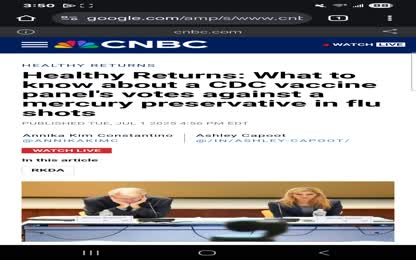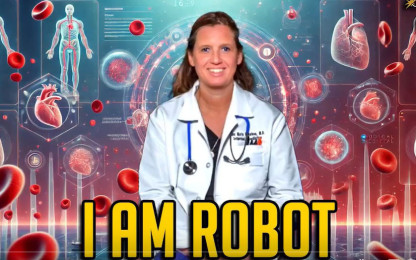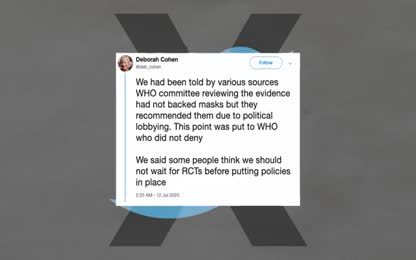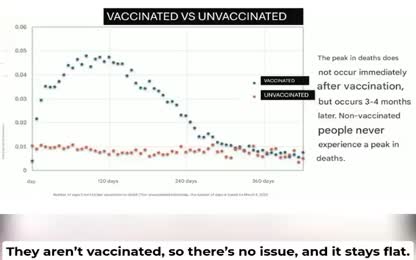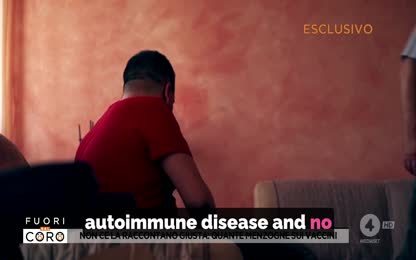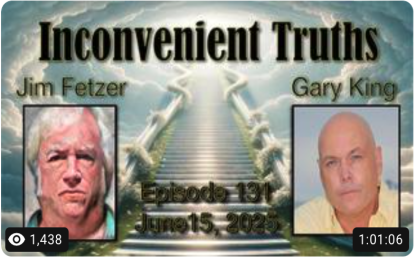Advertisement
New Zealand Covid-19 vaccination database admin turns whistle-blower and reveals NZ vaccine deaths
OMG - PLEASE SAHRE.
New Zealand Covid-19 vaccination database admin turns whistleblower and reveals how many people died after taking bad batches of the Pfizer vaccine. This must be investigated. If this data of mass vaccine casualties is real there must be accountability. also clip shared hear on X - https://twitter.com/KimDotcom/status/1730230555000574003?ref_src=twsrc%5Etfw%7Ctwcamp%5Etweetembed%7Ctwterm%5E1730230555000574003%7Ctwgr%5E7a268db79c87df796ec990c502b6f999283908ec%7Ctwcon%5Es1_&ref_url=https%3A%2F%2Fhalturnerradioshow.com%2Findex.php%2Fen%2Fnews-page%2Fworld%2Fnew-zealand-arrests-government-database-admin-for-revealing-24-death-rate-for-certain-covid-vaccine-batches - - https://halturnerradioshow.com/index.php/en/news-page/world/new-zealand-arrests-government-database-admin-for-revealing-24-death-rate-for-certain-covid-vaccine-batches
- Category: Covid Related,Pursuit of Truth,Truth Teller / Speak Out
- Duration: 51:57
- Date: 2023-12-03 15:46:31
- Tags: new zealand covid-19 vaccination database admin turns whistle-blower and reveals nz vaccine deaths
15 Comments
Video Transcript:
I'm Liz Gunn and I come from a background as a lawyer and then years in mainstream media. I now do freelance media and I stood in the recent election in New Zealand. As part of my standing in that election, a man approached me and asked me if I would talk about with him some statistics, some data, a large body of data that he was brave enough to come forward and offer in order to help the world. I can tell you that I have never worked on such a detailed case. I have never worked on such a demanding story in all my years in both law and media as this one. It has demanded fast, devious attention to detail and we have taken it to statisticians here in New Zealand and elsewhere around the world. There is a purpose to this. The purpose is to bring down the greatest evil I believe that has been perpetrated on the most human beings around the world at the same time. To that end, I cannot put into words the courage of this man whom I will now introduce he's willing to have his face on screen. I have always referred to him by his nickname which is ironically Winston Smith. I do not know his real name and I am happy with that. Welcome Winston. Hello. Cook us before we get into the data. Take us to the beginning of your journey. How did this come to you? Right. Well, I was involved with building a project that helped with implementing a vaccine payment system for our providers. It's called a pay per dose system so it means that every time someone gets vaccinated they get a payment for it as a provider. I helped build it. I implemented it. When I was looking up the data, which is part of my job, I noticed some discrepancies with the data of death. People getting people dying within a week of being vaccinated. So what did you notice when you first started to look at this data as you were building it? Well, since the system went live, we noticed that people would die in almost straight away after being injected. That prompted my curiosity a bit. I am a scientist by nature. I love science. It's my all-time favourite. I've got a master's degree in science. You are working for the New Zealand Ministry of Health. You are building this site and you are starting to ask questions. What happened then? What I did was some investigations into what has actually gone on. Because I didn't believe in media. I've always questioned the media. I've been awake for at least 10 years. What do you mean by awake? A wake is like, you kind of know that when you're being lied to and I think I'm hopefully going to show people how it has been lied to in this. Yeah, they are. So I just need people to be skeptical. Even if you're being jobbed a dozen times, it doesn't matter. Just look at this data. Just look to see what it says. And that's from a purely statistical scientific standpoint. I'm proving wrong. This is real hard data. It's undeniable data. It's the government's own data. They can't deny it. It's 100%. So what I did was looking at it. Looking at our government's data that we were called on births and deaths. I was just curious to see if the death rate was going up. And sure enough it was. Just I everyone else was saying on YouTube in that. All these reports coming out saying, oh, death rate is going to be 6, 7% in some countries. So I thought, OK, maybe it's New Zealand or something. And I've got access to that data. And I ran some crews and sure enough it was. So the first question of the data or the mainstream media would be, well, of course, it's going up. There was COVID. COVID was causing the deaths. Not the COVID jaab roller. What do you say to that? Well, that is a good reason why you would see the death rate going up. But like I said, I'll just show you. Let's go into the data. OK, so I was curious about the death rates, as I said. And what I did was run a query to see how many days where more than 120 people were dying. Why 120? That was just a magic number. It was just a line in the sand. It seemed appropriate to New Zealand because where a small country in America would be much higher, obviously, in Britain. And so 120 was a magic sort of point where you would see a lot of days where it wasn't 120. Because it would have been in the past unusual to have 120 daily deaths. That is right. That is the magic point. If it's lower than that, then it loses its relevance. It pisses us out lots of days where it's over 100. You would just see every day, basically, over 100. But 120, you get that sort of cutoff point where a lot of most days should be under 120. But then you get a few days which are over 120. So what I did was go back to 2000. 2000, I like that. It marks it out as a talking point of day. Oh, that's an unusual day. We've had 120 deaths. This was the New Zealand before the general. Exactly. I get that. So we've got 2011. And we've got the second, we've got the 22nd of February. And we've got 268. Yep. And that is the Christchurch earthquake. Ah, so that was a real outlier. That's an outlier. OK. And it also one of the days that the data sent. So then after that, we've got 2011 again. 2011. But that is, that's February. And again, we don't have over 120 deaths until July. Until July. Yeah, but that's the midwinter flu season. And you expect that in the winter more people die. It's just a statistical fight. And they're just above the 120. All right. Obviously, it must have been a fairly bad winter. So we've had a five-month gap with nobody, but no numbers above 120 a day die in New Zealand. And then the next one down, if you look at that, is... 2014. If it wasn't in so almost two years there, where nobody... There was no one, no numbers, or 120. And that is the eighth of August. And we've got 135. And probably flu. Big gaps, three-year gap. Middle of winter. OK. Yeah, a big gap. So again, you've got another one there. And that. That's again in August. So I've obviously got something going on. Yeah, which is, you know, winter. 2015, July. Yeah. And then 2017. Oh, just another year. So between 2015 and 2017, New Zealand did not have one day over 120 deaths. That's exactly right. And then again, this is very telling. You got the mid-winter flu season again. Yeah. 2017 must have been quite a bad flu season. A number of months here. So we're going through it from June in 2017 through to August. Yeah. We've got August. We're still 2017. But they're all just above. Most of them are just above 120 deaths a day. Apart from. A couple, 141. 1 at 159. All right. So, but then 2017, 2018, you only have one. Right. 2019. The 18. We've only got the second of August. We've only got one day. And that's 121 days. Then we don't have more than 121 deaths until 2019 and March, the 15th of March. Right. And then 2019, again, but flu season. And then nothing. So if you look at the bottom there, for two, for one year, 2020 is quite teeth is nothing. Right. So, 2021. This is before the pandemic as well, by the way. So we have our role in the middle of 2021. But 2021 itself, not a big year. Not a big year. So that's all 2021. And those are the only days in 2021 before the roll-up that were above 120. Now the vaccine roll-up comes into full effect. We've also got COVID, which I'll refer to in another graph. But 2022, check this out, right? This is April, the 20th, 2022. Just after the vaccine roll-up. Yeah. So we've got it. We've got 151, 128, 137 dead. Wait a minute. This is every day. Yeah. So as you've seen now, from this point onwards, this just keeps going almost every day. Going. Here it is now every single day. Going. And going. And they're all above 120. Yeah. Still 2022. Going. Going. So already evidence of excess death in the past. This is the same. 100%. Wow. Wow. And still it's going. Still going. Now we're heading to that in 23. Has it stopped? Has it slowed down? Well, you tell me. Still going. This is 2023. We're still in 2023. So we're before we had gaps on month or a year or two years, three years, no gaps. Not. We're not now. Again, how do we know this is not COVID, did it? COVID, the pandemic sold to us. Because the COVID deaths stopped. And I'll show you that on the World Dometer website. You can look at the study yourself. Check it out. Please check it out. The World Dometer website shows that COVID deaths stopped at a certain point in 2022. Well, look at that in a moment. One of the things you've said to me Winston is prove this wrong. Go out of your way to prove this data wrong that it's linked to the roll-up of the COVID Jaffs. That's what you want, isn't it? That's what I want. Prove me wrong. And I will say, well, Winston is doing this. He has said to me, I would love to be proved wrong. I wish it was not the Jaff that was doing this two New Zealanders and to people around the world. I wish I was wrong. Now, that is a man of such sincerity. The data is screaming at him. What it is. Well, that's what science is all about. It's you put a theory, a hypothesis up there, and you invite criticism. You want to be shown that it's wrong. I've got, I wish to my heart that this wasn't the thing. I wish I wish it wasn't what it is. Yes. I think we both do. It's so... It's nothing. It's nothing. It's been a terrible nightmare. So I put the cell phone in a chart for a month. So we can see what I first saw as I thought, well, what am I really looking at here? So what we have here is a graph of the daily deaths where more than 120 people have died from January the 11th to September 2023. So on the left there, the big road lane is the Christchurch earthquake event. So that is the outlier. And that's a lot of people dying on that day. From there, the next line where you get more than 120 people dying, is sometime 2012. Then you get nothing for a year, 2013 doesn't have any. 2014, you got a couple. Then nothing, 2016, you got one. Then nothing until 2018, where you get a whole bunch of whole cluster, that's probably due to a flu of a epidemic. Because always these spikes that you see, these black lines previously on the left hand side, they're all due to the winter flu season. So you got to remember that, they all, all these deaths happened June, July, August. So they're in 2018, we had a big flu epidemic. Moving on to the right, you get another one. Then the next red one, the Christchurch Massacre, which was in 2019 in March. But from that, you get a cluster in 2020. A whole bunch there. May have been another bad flu season. We don't know. But then from 2021, in a way, you see a black line there, a parent, and then it's like a flick of a switch. Suddenly the black lines get closer together. And there's more of them, very thick black lines there. So this one here, pick deaths with COVID, with or from COVID. But then the deaths from COVID, if you look at the Worldometer website, it correlates to that. That is the same time, and they say that over 60 people died with or from COVID. Then after that, it suddenly, suddenly drops off. So after that, you only get a couple of people a day dying with or from COVID. So if you go back to the chart there, in that case, you would expect to see the black lines disappear, because no one's dying from COVID anymore, right? But you're not, you're absolutely not. You're seeing the black lines. There are more people dying than ever before. These are the biggest number of deaths we've seen in history of New Zealand. The death rate has gone up 6%, 8% year on year. Even after COVID wasn't a thing, the death rate has still gone up. And that's illustrated here by these black lines, which are still going on. And we're basically getting in Christchurch, Mexico, now, on many days in New Zealand. Yes. Would you agree with me? That's right. So every other day, we're basically seen another similar number of people in the Christchurch, Maseca. But it's not being mentioned by anyone in the news. Menstream media is not picking this up. But there is an increase in the death rate. Nobody's talking about it. But we've got to know why there are excess mortality rates. Now, just in New Zealand, but across the world. And hopefully we can explain that. This here is daily deaths of more than 120 from January 2020 to September 23. And again, we see the role that's born of workers February 21. From line workers March 21, the elderly. May 2021. May 2021. And then the rest to July 2020. OK, look what happens after we've all been injected. These lines start to appear. And again, we're looking at number of deaths. Number of deaths. Over 120. But the number of deaths, over 120, each day, with it. And where we see a thick black line, that means a number of deaths. Yes, yes, and a wrong. So when we get this thickening of the black lines, we know that there are many days where we've got this excess mortality. All right, let's go into more specific sites and look at excess deaths from that perspective, Winston. OK, so what we have here are the 20 worst sites for excess deaths. That means excess mortality. So the sites in New Zealand, there are 1,391 individual vaccination sites. And we're looking at the mortality rates of each site. So from that, we look at the top 20. And if that's the heat map, that's... And if this was a normal, dead distribution, you would see more in the big data centers. This is not normal to see on the South Island, later on, because the South Island is not densely populated. So for that excess, it should reflect mortality rates across the whole country, which is the background mortality rate, something like 4.75%. Some of these rates will shock you. So this is the slide, but it's in Google Maps now. So again, 20 worst sites for excess mortality rates. And as you see, 10 of them are in Christchurch alone. Wow. Down to that. Let's have a look. So let's just stop here. And more Christchurch central as well. Not out in Littleton, but look at this. Yeah. End out near the Antarctic center, central bins. We've got sedenum. Yeah. And if we just zoom out and show you... In the cargo. And if you look on the left-hand side, in the cargo, poor in the cargo, it's, they've had an unbelievable experience. They've had a total number of site vaccinations of 837, and a 30% death rate. 30%? So most one in three people who were vaccinated at this site are no dead. And what have we got here? Total clusters per site. The clusters we're going to talk about later, because it's just the death ratio. The underlying mortality rate should be 0.75% ordinarily. But in this one particular site, we've got a mortality rate of 30%. That is staggering. Yep. And in the cargo of all places. What else do we got in the South Island? Can we go in on a call? Yeah. And go. We have this pharmacy here. They've vaccinated 16 people. Almost 20% one in five of them are dead. And that is La Hood's pharmacy. Yeah. And go. Sorry, yes. What do you make of, if you look at the bigger map of the South Island focus concentration? I can only make assumptions. But something is clearly wrong here. So the vaccine would have come in. However, it got to the South Island. We don't know how it was stored. However, it was transported. But something is not right here. So there might be something in the batches themselves. I can only guess at this point, but the statistics are clearly said that there is something wrong. And it's concentrated in the South Island. That the mortality rates are far in excess of what is normal, far in excess. So we get back to the crucial point of your data to me, still Winston, is this is proving that this is not able any longer to be put down to natural causes? Or this would have happened anyway. The data takes it away from that. Exactly. This cannot be a natural event. This is my name. We're going to look into that more. I want to add a very poignant point here, Winston. We haven't mentioned this so far, but we are focusing on deaths in New Zealand. For every death, I can only imagine. And I refer to this in an earlier message, the number who are injured. We don't have that data here. We don't have that data here, because death is the ultimate adverse event. It's undeniable. It's binary. It's you that alive are dead, one or zero. Adverse events, we have got no idea. And if it's an adverse event, they can argue about in courts of law, add infinitum, as you know. But with an adverse event like death, then it's harder to prove, disprove, and statistically, it's very difficult for them to disprove this, because as I will show you, stats don't lie. And this is government data. This is government data, and we don't know the government collection of adverse events data, because many people I've interviewed have been told themselves on going in and saying, I believe the jab caused this injury. They've been told you're just anxious. So we don't have potentially a dose. Nobody knows this data. Nobody but me in New Zealand has seen this data. Now I'm giving it to the world. Explain why. Explain that. Because it's a payment system, and I'm the database administrator for it. I'm the only one, because New Zealand is a small country. You can get away with one database administrator to do this. So I am in a unique position in the world, and because New Zealand is a tier one country with really good IT, I was able to manage and build the system. And as be the only database administrator needed to look after it. In other countries like America or Britain, you need a whole team of people. So it would be very difficult for one person to get access to all of this information. But in New Zealand, because of the size, and because it's got really good IT, I happen to be the one. And I think the universe has caught me here for this reason. So New Zealand becomes a seminal example for the world. Yes. We are a P3 dish here. Yes, we are. And if it's happening here, going to you, it's happening everywhere. And we need more people like me to stand up and just come out, don't be scared, just do it. There's a lot of emotion when you speak like that. Can you briefly... Before we go to the stats, tell me what this journey's been like. It's been a roller coaster. But like I said, it's harder to look than to leap. Now I've got to leap. Looking at the stats, there's tormenting apart for years. I've got to do something about it. On that note. On that note to those who say, why didn't you come out sooner? Address that point. Because the data wasn't there, I had a suspicion, you know, with science, you always question. So obviously question things right at the start. See what's going on. The data wasn't there to do this analysis. Now a couple of years down the track, we've got a huge body of data, 2.2 million people have been through the system. It's a good data set. It's an accurate data set. It's not 100% complete because there are other systems out there. I do not have access to. But this data set is accurate. And I can guarantee statistically correct. So because of the time that I took to gather this data, I couldn't go out right at the start and say, oh, there's something wrong here, there's something wrong. Like one day after it was rolled out, someone died. That's insignificant, unfortunately. And it breaks. In significant data. Data was for it. It breaks my heart. It breaks my heart. That so many people are lost because of this. And it's the government who are behind it. Why they're doing this? This is their people. They should, if there is a safety signal, any safety signal at all for a vaccine, it should be withdrawn immediately. But they've just ignored everything and just gone straight ahead and just put their headphones on and just ignored it. Ignored all the voices saying, screaming, this is a danger signal. This is a killer. And it is a killer. But they've just gone straight ahead with it. But it has to stop now. So that implicates Bloomfield as it was being heading up the Ministry of Health. It implicates our dern. It implicates everyone. All of that absolutely does. But maybe they've got plausible deniability. Meaning what, explain it. Meaning what they didn't know. They deliberately didn't know. Could they not have known this? Could this possibly? Maybe I can't speak to that. All I can say that is that the government and the media have ignored voices like ours, like yours for too long. And when you've got hard data, when you've got government data, it is impossible for them to deny. So the argument could be they may not have known, but they could have known had they chosen to listen. So after those of us pleading with them, they're deliberately too research. Deliberately cancelled voices, which told them to look at the data, yeah, to look deeper. So, and that's gone on across the world. There's people like Trudeau in Canada with the truck drivers. He just didn't listen to anyone. He just went ahead with whatever a gender he had. And I'm not going to talk about that. That is a separate thing. All I want to talk about here is the actual data, the facts. We know there are brave politicians across the world pleading still, Andrew Bridget in the UK. Absolutely. These people deserve to be heard now. Absolutely. And they will be heard. The people will not be silent on this, because you know, he's stood in Parliament, brought me to tears when he's been in speech and there was a huge opera in the public gallery. I'd say, this is what Parliament is about. This is the people speaking. And he sat at the time. This is not the first debate on excess deaths in the world, but it is the first debate, but it will not be the last. It will not be the last. But he was there in an empty Parliament, Regalery, except for the public. Except for the people. And there were thousands outside. And the people know, the people will know when something is not right. And it's getting to that point now. The people in the cargo and go, will know there's something not quite right. And this is the answer. This is what we're going to tell now. Look, deeper question. Because you will know that it doesn't seem right. Well, why are all the old people dying? That they've never had so many old people die before. Statistically, this explains why. It can only be from the vaccine. It can only be from that. Not the other explanation is can be used to explain it. It's not normal, but here we have the data saying why. Let's look further into it. What else have we got here? OK, so that's the heat map from the whole of New Zealand. And we've talked about that. So in Christchurch, this is the ratio of excess deaths and statistics will get onto that. And a bit here, other ratios for the top 20. So if you look at the top right there, the average New Zealand death rate, the mortality rate, is 0.75. 0.75%. That means seven people per 1,000 people will die in one year. So that you see that the top sites with mortality rates way over, way over. This is huge. So if it had been safe and effective, we would have expected 0.75%. What we have in the site total death count, and we've got total site vaccination. So this is really official data. And we've got 31%. Nearly 32. So off those 191 people who were vaccinated, at that care home, 61 of them are now no longer with us. Wow. And I would remind people we were sold the jab to protect the old people. Exactly. And this, in terms of temporal connection to the jab, there'll be a time connection. It won't be too long after the jab, will it? We don't know a month or two months. That is data that is captured. But we will have to analyze that later there. Because all I'm trying to get it now is the general statistics. I mean, these numbers, these should be for all age groups. Maybe you've got one like care home, a care home, maybe elderly, average age, maybe 80. But even so, even if you think that the age group is 80 to 90, the mortality rate of that age group is maybe 20%. Not 31%. 32%. Not 32%. The reason I asked about the temporal connection is I know the third site, which I've looked at in detail with you and we'll get to that where we have a 30%. Right? I know that the jabbing took place in very close time frame in some of those groups and that the deaths were within a few months. We'll look at that in a moment. But look at the numbers. And this is a big data sandwich, which makes it statistically more relevant. The higher the number of vaccinations, the more accurate the statistics are going to be. So we've got 80 to 37 with a death count of 253. Almost one and three people who got vaccinated at this site are now normal with us. And that site, Queen's Park, is in Imbecagal. And here we have another residential elder care services. We've got 923 of them, jabbed 276 dead, which brings us to nearly 30%. And yeah, again, to your point, the vaccination was promoted to protect the elderly to serve them. So what is the exact same from if they were going to die anyway? How much longer did it buy them? Are we talking it a week a month? What was the purpose? Here's one of our Christchurch ones, the doctors Christchurch south. We've got 48 vaccinations, 12 dead, that brings it to a quarter of those jabbed dead. That's way above the odds. Way above the average. When we take it back to point to that. That's exactly right. And a lot of sites, I've got the mortality rates under 1%, which is what you would expect. So there is something going on here that cannot be explained. All right, Winston, let's look more specifically at batches. A lot of people want to know what was my batch. What can you do to help keep us afoot? OK, so what I did with the data was look at the top 10 batches that had a high death count, high mortality rate. And I put them on a chart, which you can see up there. So it's got a batch ID, which is our end-term number for a batch, but you can easily get the Pfizer batch ID from that. It shouldn't be too difficult. Tell us more about that, because a lot of people will say, hey, that's only the top 10. I want to know my batch. What would you advise? Yep, you can do that as a website, find my batch for the whole world. They can actually find that. And we can list this on a website, the whole number of batches. There are 119 individual batches, so far in New Zealand. 119. Of the Pfizer? Of the Pfizer. Actually, no, of all of them. Because we have Moderna. We have AstraZeneca. But they're only fearing far between mostly its Pfizer, mostly its Pfizer in New Zealand. So people can find that. Find my batch. Yes, they should be able to. Yes. So what I did was our internal batch ID, I counted the number of vaccinated within that batch. And then I found out who was dead. Wow, let's have a look. And so we then look at the percentage of the ratio. So do we know if these are all Pfizer, the top 10? And this is Pfizer's batch number one. We've had 711 from batch number one vaccinated. 152 of those died, which makes a 21%. Percent. Death rate. mortality rate from mortality rate. They are high. Now, what's our normal, that we would expect? It should be the light of mortality rate. 0.75. 0.75. With these batches against all edge groups as well. It's not one particular batch for one particular edge group. It's across all edges. So all the vaccination centers, whoever rocked up on the day, whatever edge you were. And then it would average out. It would all average out. So there's not one particular batch that points to one particular edge group. So looking as if batch number eight, the second one, 221, job 38 did. That's a 17% mortality rate. Batch number three here. And we've got 48 out of 310. So that's a 15%. And if we go right down the top 10, batch 71, 11,000 vaccinated with batch number 71, 498 did. And that's a 4%. Now, you say down the bottom on the screen. Could you just tell us what this is saying? We are. The chances of these batches not being a killer are 100 billion to one. Explain that as a statistician. Yep. Well, if you look at the underlying mortality rate, and then you look at the ratio percentage here, the top one, the chances of that occur naturally by chance is almost impossible. It cannot be due to chance. So statistically, what we're saying is that there is no chance that this vaccine is not a killer. So with our 100 billion to one, are you saying you'd have to jab a hundred billion people to get these statistics? Wow. And we've got 2.2 million on our system. 2.2 million people. 2 million Kiwis. And we would have had to have jabed 100 billion to get these kind of results. Now, a statistician will know exactly what that means. What they say is almost impossible. Almost impossible. So they'll never rule it out completely. Statistical numbers. 99.9999. Modern names. So it's, yeah, literally it's an impossible event. So you look at that causality. If we rule a chance, then what else do we have? What was happening at the time? What else do we have to cause these deaths? And it can only be the vaccine. That's the only thing left. Because if we look at this, we remember that the number of COVID deaths by now was dropping wider. Yep. And we were looking at that. These are all across all edge groups as well. So it's not one particular edge group. It's across the general population. So the background mortality rate, 0.75, should be reflected in all these batch numbers. But it's not. Wow. So I mean, this is alarming. Even looking at, look at the second, second from the bottom. The action number 62,8000 vaccinated, 831 did. And that's still nearly a 5% ratio against 0.75. Yeah. And the next one I looked at was there are different ways to look at the dead. You can slice it and bite it. So another way I looked at it was other vaccinators themselves, what are they doing? Are we looking at some who have got a higher mortality rate than others? And sure enough, if we look at the next one, unfortunately, there are. So what we have here are the top 10 vaccinators who have the highest ratios of mortality. For privacy reasons, we have redacted the names of those jabbed and the names of those jabbed. Yeah, we have to. Yeah. So we've just called it vaccinator one. Yeah. But these are individuals. These are real people. These are real numbers. This is government data. So the top V1 has vaccinated 246 people in 60 of them are known along the list. That is nearly 25%? 1 and 4. Nearly 1 and 4. That person's vaccinator is no dead. And you can come up with any number of reasons for it, but this should never happen. This should never happen. If they were all doing their job correctly, if it was a normal vaccine, who would be 0.75. And if you were arguing, OK, there was one vaccinator who was incompetent not doing the job properly, that's an aberration, but look at the other numbers. So it looks then we start to say, what is it they were putting into people's bodies? Because the uniformity is what they were putting in. Look at this one. 621 by vaccinator, the third highest vaccinator. 621, 104 people did, nearly 17% of the people they jabbed. Yeah. And unless they go around, determining that ill cancer wards and injecting people, who they know are going to die, then there is no other explanation for this data. And why would they do that anyway? You know, it doesn't make any sense. The vaccine has been to protect those people. It's an English pretentable of the ill, but it looks like we have a huge mortality rate. Look at this one. The fifth vaccinator, 5, 1682 jet. And of those 239 did. These are big numbers for people who've been jabbing New Zealanders to live with. Big numbers. Now explain it cluster, because not everybody gets fancy. So what I found with the clusters is that if you go to a vaccination center within a few hours, there'll be a few hundred people going there. And you're all vaccinated. And now you're no longer with us. If you're all vaccinated within the same time period, that is a cluster. So what I looked at was groups of three or more. So if you're vaccinated one after the other, and you're no longer with us, that is a cluster. But what I found here in the big one, which I'm just going to show you, which is the one in goal. No, in Vicargol, sorry. Queen's Park Medical Outreach. Again, we're back in the South Island. Back in the South Island with Wayne Wall. It just got out of here. It just got out of here. And the North Islander is there on the big screen. Down here. And there are sure 30%. So what we've got here, 18 clusters, 18, three or more deaths per day from a cluster. Yep. And I'll just bring the... And here we've got 10 clusters of three to 10 deaths per day, three clusters of 11 to 20 deaths per day, and four clusters of 21 to 30 deaths per day. So there are numerous clusters from this one site, which is Queen's Park Medical in Galer Street, in Vicargol down here, who's got an unusually high number of clusters. This has been incredible. Why is it incredible, explain? Which in the last statistically, this is impossible. Unless there's something wrong with it, I see. So massive deaths. Yeah. A huge ratio. Just explained so that site death ratio, normally it's 0.75%, and we've got 30%. Yep. And I'll show you one of the clusters, if you just give me a moment, I'll just put this on the big screen for a can. Let me just escape, but... I'd like to go into the details of the clusters, because I'd also like to look at the timing, the timing on the jabs, to see if there was proper due diligence done, in terms of taking case histories, in terms of talking to people about any hesitations they might have had, all of that sort of due diligence that we assumed would be done in relation to a vaccine. If we look at the timing on these jabs, we may well see that that simply would not be possible. So that big sequestion was there, informed consent to the jabs. And if you look at the times of vaccination, you'll see that that would be impossible. Winston, I know when I call you a hero, that it doesn't exactly sit with you, for me, anybody with the courage to speak the truth, in the face of risks, particularly from a would-be tyrannical government, a government here in New Zealand, and many governments around the world that are silencing the truth, to the point where they're willing to even put people in jail for telling the truth to the people of the world, to me, that is heroic what you are doing, what you have offered to the people of New Zealand and the world in this interview. Why do you demeure when I say you're a hero? For the record, I'm not a hero. I don't want to be known as a hero. It's not who I am. The heroes in all of this are the guys who stood up at the gates of the freedom march, who were brave enough to say no to this, who were brave enough to push back. There were the ones who were called by the guys in Parliament, a river of filth, when no one went down to see them. The real river of filth were the ones inside the chamber on that day, and people like Malad, who turned the water and the music on at three o'clock in the morning when there was children there in the middle of a hurricane, that was just awful. Those guys who stood there, they're the heroes, are really mean that. They are beautiful people. And the ones who took the rubber bullets, the women who took rubber bullets from the police, who were meant to protect us and service, they're the heroes, not me. The ones who stood firm and lost their jobs just because they were told to get a procedure that they didn't want, and they were brave enough to say no, they're the heroes. I'm not a hero. And that goes around the world to the heroes in Canada, who inspired many of us. The truckers, and you got punished by Trudeau, who I see as just indesevil twin, you got punished, your bank account was shut down, but you were heroes to us in New Zealand. There were many in London, who much, those people in Melbourne and Australia, who also took rubber bullets when they were on a cenotaph and memorial to what our forebares did to fight tyranny in World War I. But Winston, without you, these jobs could still go on. And without this information, we could find that someone like Bill Gates heading the World Health Organization, basically, the Gates Foundation is running that correct organization. Without this, we could be finding that another planned demic, another manipulated event could occur in which all people of the world are forced jabbed. What do we say to the people of the world who can never go along with this again, are forced jabbed? What is the message? If this goes somewhere to end in it, what we've experienced in the last two years, if it helps in any way, then I've done my job. We've taken it a wrong turn, down a very dark road, over the last two years, humanity, the whole of humanity, not just New Zealand, like everyone. And the further we go down this road, the harder it's going to be to get off it. And if I shine a light back to the main road, so we have done my job, we have to get back to where we are as a human species, as a, you know, as a race, as a custodians of this planet. If we do this to ourselves, then there's no future for us. We cannot allow this to happen in generations to come. We're doing this for our children, so they don't have to experience this. This is not where we should be. This is not where we want to be. At this point in time, we cannot allow this to happen again. As Powerfully said, and any conspiracy theorist to my mind deserves also enormous praise, showing a capacity for critical thinking. Conspiracy theorists should be a term of honor, a capacity to bear ostracism from society, a capacity to continue to critically think, to stand outside the herd, to say, I know it's wrong, and I will continue to speak up. I think we have to look at these manipulative terms designed to silence. When we have censorship, we no longer have democracy. Exactly. Yeah. And a lot of scientists in the past have called conspiracy theorists, so we're prosecuted for it. All we're doing is trying to speak the truth. And as history shows us, some of the people we've thought with conspiracy theorists have been proved absolutely right. If you said right out of the star, that the Wuhan Labelic theory was a thing, you are a conspiracy theorist. Now it's shown pretty much beyond doubt and it actually came from the lab. And then if you said, well, Fauci is behind it, because he was doing Gana function research. Again, if you said that earlier, you were a nut. But now it's actually coming out that he was doing Gana function. And he was behind the whole thing. He was behind the virus. So, yeah, it's just a question of history, which side of history are you on? And as it pans out, will history prove you to be right or prove you to be wrong? And I think in a lot of cases, you're labelled a conspiracy theorist. And in the future, you'll be labelled as someone who just knew what it was at the time. A different kind of hero. Maybe.










 Donate
Donate

